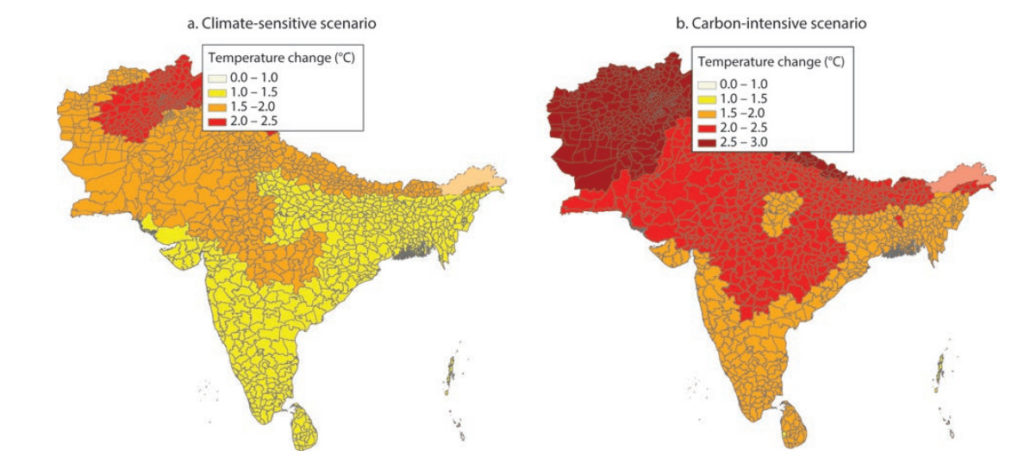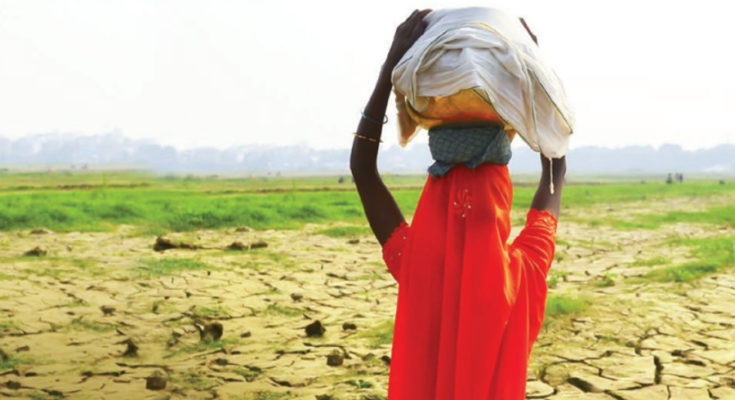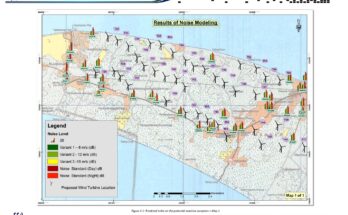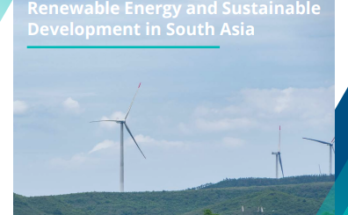Climate change is been discussed world over as one of the hottest topics related to the global environment. Many countries in the world are already experiencing the direct effects of the climate change in various adverse weather conditions like droughts, flash floods, extreme temperatures, sea level rise and storms. Yesterday (28th June 2018) World Bank published a 125-page book on a study of Climate Change in South Asia and Its Effect on Living Standards of the People in this region. According to this report 800 million people in the region are at risk of diminishing living standards as a result of climate change.
This book builds upon accumulated research on climate change by analyzing how trends in average temperatures and precipitation patterns over the coming years will affect living standards. It uses weather data from global climate models to predict changes in average weather at the local level. The book analyzes these climate data in combination with household surveys to explain how changes in average weather will affect living standards.
This study reveals how the changes in average weather conditions will differ from country to country in the region. Furthermore, the book analyzes how living standards, measured by per capita consumption expenditures, will be affected by these changes in average weather.
Average temperature is rising!
For this comprehensive report, analysis of the relationship between weather conditions and living standards have been conducted separately for individual countries. The combination of localized climate projections and household survey analyses yields a granular picture of the expected effects. The study shows that average temperatures have risen over the past six decades and will continue to rise. Over the 2050 horizon, it predicts more warming inland and less warming in coastal areas. Changes in precipitation patterns have been more mixed, and this diversity will persist in the future. These weather changes are expected to result in a decrease in living standards in most countries in the region, compared with a situation in which current weather conditions are preserved.
A Vulnerable Region

South Asia is recognized as being very vulnerable to climate change. The region’s varied geography combines with regional circulation patterns to create a diverse climate. The glaciated northern parts—which include the Himalayas, Karakoram, and Hindu Kush mountains—have annual average temperatures at or below freezing, whereas much of the Indian subcontinent averages 25°C to 30°C (77°F to 86°F). Both the hot and cold extremes are challenging for human well-being, and climate change heightens these challenges. Increasing average temperatures and changes in seasonal rainfall patterns are already having an effect on agriculture across South Asia. Low-lying Bangladesh and the Maldives are increasingly vulnerable to flooding and cyclones in the Indian Ocean. The scientific literature suggests that such events will grow in intensity over the coming decades. Dhaka, Karachi, Kolkata, and Mumbai— urban areas that are home to more than 50 million people—face a substantial risk of flood-related damage over the next century. Average annual temperatures throughout many parts of South Asia have increased significantly in recent decades, but unevenly (map O.1). Western Afghanistan and southwestern Pakistan have experienced the largest increases, with annual average temperatures rising by 1.0°C to 3.0°C (1.8°F to 5.4°F) from 1950 to 2010. Southeastern India, western Sri Lanka, northern Pakistan, and eastern Nepal have all experienced increases of 1.0°C to 1.5°C (1.8°F to 2.7°F) over the same period. The precise magnitude of the estimated temperature changes varies across locations, but the direction of the changes is unambiguous.
Climate Change and Living Standards
Climate change includes rising temperatures, changing precipitation patterns, and intensifying extreme events, such as storms and droughts. All these have profound repercussions for societies, from sudden economic disruptions to a longer-term decline in living standards.
Rising average temperatures can affect living standards through diverse pathways, such as agricultural and labor productivity, health, migration, and other factors that affect economic growth and poverty reduction.
- They can dampen agricultural productivity, leading to a decline in living standards for agriculture-dependent households.
- A warmer climate can also increase the propagation of vector-borne and other infectious diseases, resulting in lost productivity and income.
- A warmer climate can increase productivity in historically colder regions, such as mountainous areas.
- Days of extreme heat are generally correlated with lower worker productivity, especially in areas that are already warm.
- A changing climate can force people out of their traditional professional domains, resulting in individuals not earning as much income.
The primary driver of climate change is GHG emissions, with human-caused emissions as the major contributor. Projecting future climatic changes requires creating a scenario that projects the amount, timing, and type of future GHG emissions by human activities.
In this study climate change has been projected in two ways as Climate sensitive model and Carbon intensive model. Climate sensitive model projects the climate change assuming a global action in place to control the climate change. While the Carbon intensive model projects the climate change without such an action.
The average prediction by these climate models is that annual average temperatures in South Asia will increase 1.6°C (2.9°F) by 2050 under the climate-sensitive scenario, and 2.2°C (3.9°F) under the carbon-intensive scenario. These increases are relative to 1981– 2010 conditions (figure O.3).
The book shows that failure to reduce GHG emissions and take measures to build climate change resilience will lead to diminished economic performance in most South Asian countries. At the same time, changes in average weather may have some benefits for Afghanistan, Nepal, and high-elevation areas of India because of their cold climates.
Changes in average weather are predicted to reduce living standards in Bangladesh, India, Pakistan, and Sri Lanka, relative to what they would have been with the same climate as today. By 2050, under the carbonintensive scenario the declines are projected to be 6.7 percent for Bangladesh, 2.8 percent for India, 2.9 percent for Pakistan, and 7.0 percent for Sri Lanka. For countries with severe hotspots— Bangladesh, India, and Sri Lanka—the negative impacts are predicted to be even greater. Translated into gross domestic product (GDP) per capita, changes in average weather are predicted to reduce income in severe hotspots by 14.4 percent in Bangladesh, 9.8 percent in India, and 10.0 percent in Sri Lanka by 2050 under the carbon-intensive scenario compared to the climate of today.
Climate effects are smaller under the climate-sensitive scenario. This finding highlights the importance of taking actions to reduce GHG emissions, and provides an additional economic justification for continuing to work toward meeting the targets established under the Paris Agreement.
Hotspots

In this study areas where changes in average weather will adversely affect living standards are defined as hotspots. The map below shows the hotspots in south Asian region as projected according to the two climate change models described above.
In Sri Lanka, the Northern and North Western provinces emerge as the top two hotspots, followed by the much less densely populated North Central Province. The Northern Province is home to large numbers of poor and displaced people, so the effects of changes in average weather will add to these challenges. The North Western Province, in turn, is one of the driest regions of Sri Lanka. The highly urbanized and densely populated Western Province, which includes Colombo, is also predicted to experience a living standards decline of 7.5 percent by 2050, compared with a situation without changes in average weather. This is a substantial drop, with potentially large implications for the country, given that the province contributes more than 40 percent of Sri Lanka’s GDP.
How can we overcome this challenge?
The study it self suggest some key actions that we can undertake to minimize the effect of climate change. It says that, investing in skills, health, knowledge, better infrastructure, and a more diversified economy should reduce climate hotspots at the household, district, and country levels.
For Sri Lanka, the policy choices considered include enhancing education, improving market access, and increasing nonagricultural employment. The analysis suggests that increasing nonagricultural employment by 30 percent relative to current levels could entirely eliminate the burden of changes in average weather on living standards; the overall impact would shift from –7 percent to 0.1 percent. On the other hand, reducing time traveled to the market by 3 percent and increasing eductional attainment by 30 percent would respectively change the impact on living standards from –7 percent to –2.1 percent and –2.6 percent, respectively. If these interventions were implemented together, living standards would most likely increase under the climate change scenario.
The complete book with the full report can be accessed through following link




